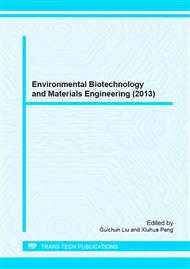p.86
p.92
p.96
p.101
p.106
p.112
p.117
p.122
p.127
Sorption of Cr(VI) from Wastewater Using Modified Chitosan
Abstract:
Chitosan modified by microwave irradiation were used for hexavalent chromium removal from aqueous solutions. Sorption parameters including pH, temperature, initial concentration and contact time have been investigated. The maximum sorption of Cr (VI) on modified chitosan occurs at pH 5,whereas the sorption capacities of modified chitosan were significant over pH 2 to 7. The results obtained from equilibrium sorption studies are fitted in various sorption models such as Langmuir and Freundlich and the model parameters have been evaluated. Maximum sorption capacity of was 147mg/g at 15°C. Kinetic models including Lagergren first-order and second-order were used to test kinetic data. The results showed that second-order has good agreement with experimental data. Thermodynamic parameters of the process were also. Thermodynamic parameters including free energy (DGo), entropy (DSo) and enthalpy (DHo) of sorption were also investigated at different temperatures. The negative values of Gibbs free energy and enthalpy changes for Cr (VI) indicated the spontaneous and exothermic nature of the sorption process.
Info:
Periodical:
Pages:
106-111
Citation:
Online since:
September 2013
Authors:
Keywords:
Price:
Сopyright:
© 2013 Trans Tech Publications Ltd. All Rights Reserved
Share:
Citation:


